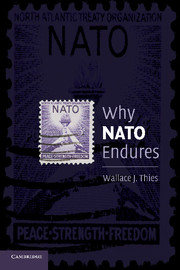Book contents
6 - NATO and the Out-of-Area Issue
Published online by Cambridge University Press: 05 June 2012
Summary
The drafters of the North Atlantic Treaty intended it to be geographically limited in scope. Article 5 states that “The Parties agree that an armed attack against one or more of them in Europe or North America shall be considered an attack against them all.” Article 6 defines the area within which the obligations of membership apply as follows:
For the purpose of Article 5 an armed attack on one or more of the Parties is deemed to include an armed attack on the territory of any of the Parties in Europe or North America, on the Algerian departments of France, on the occupation forces of any Party in Europe, on the islands under the jurisdiction of any Party in the North Atlantic area north of the Tropic of Cancer or on the vessels or aircraft in this area of any of the Parties.
At the time the Treaty was signed, many of the parties to it had important interests outside the area specified by Article 6. Britain and France had their colonial empires in Africa and Asia; Belgium, the Netherlands, and Portugal had large colonial holdings too; and the United States had worldwide interests both economic and military. Even though there was no obligation for members to assist one another out-of-area, there was an expectation right from the start that members could and should be able to count on their allies for support. Members with interests at stake outside Europe “attempted to identify their own concerns with those of the alliance.
- Type
- Chapter
- Information
- Why NATO Endures , pp. 202 - 241Publisher: Cambridge University PressPrint publication year: 2009



